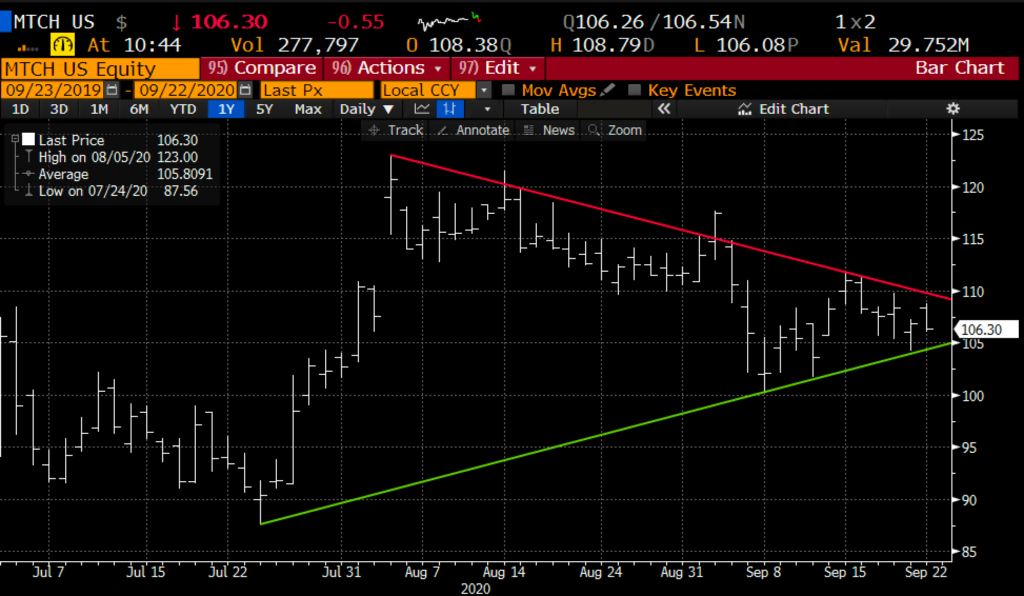On August 5th Match Group, recent spinout of Interactive (IACI) owner of online dating sights Match.com, Tinder and OkCupid reported better than expected results in its first report as an independent company, per Barron’s:
The online dating company said it earned $103.1 million, or 51 cents a share, on revenue that rose 11.5% year over year to $555.5 million. Analysts were looking for earnings per share of 45 cents on revenue of $520 million.
Average subscribers rose 11% to just over 10 million, a one-million increase from the year-ago period and ahead of analyst estimates. Adjusted average revenue per user was 60 cents.
Direct revenue at Tinder climbed 15%, boosted by an 18% increase in average subscribers to 6.2 million, although average revenue per user slipped 2%. Its other brands, including Match.com and OkCupid, notched a 9% increase in revenue year over year.
For the third quarter, Match sees revenues of at least $600 million, easily ahead of the consensus estimate.
…
The upbeat results come on the heels of a successful first quarter, which Match reported in May. It isn’t surprising that the company is seeing a big increase, given that online dating is one of the few safe ways to meet new people amid a pandemic. It’s also been quick to try to rollout one-on-one video chat to enhance the at-home experience.
The second-quarter results were above what the company itself forecast in the first-quarter report, when it warned revenues might dip slightly on a sequential basis.
The day following the results MTCH made an all-time post-spin high, trading up 12%, but has since been in a well-defined downtrend with the stock back to the level where it was prior to earnings. While there is not a ton of data to go on with the chart, it does look to be firming a little wedge with tension building with a breakout or breakdown coming soon:

Wall Street analysts are fairly mixed on the stock with 10 Buy ratings, 11 Holds, and 1 Sell with an average 12-month price target of $124, very near the all-time high made in August. Current consensus estimates are calling for a 62% drop in eps and 51% drop in sales in the current year with a 52%& 18% expected increase in fiscal 2021, which places both well below their 2019 peak.
The company will report earnings next the first week of November, and I suspect another better than expected print and this stock will be making new highs as this company is very likely to see a surge in activity as we get closer to a vaccine in the new year.
Options trade by appointment in the name, especially for a company with a $27 billion market cap, but that could change fairly quickly as a rebound in results places the stock in a bucket of post-COVID catch-up stocks.
So what’s the trade? for those looking to play for a breakout above the downtrend possibly for a move back towards the prior highs post-earnings, it could make sense to define your risk as a near-term breakdown of its uptrend could cause the stock to fall back towards support near $100. A call calendar, buying a longer-dated out of the money call and selling a short-dated out of the money call of the same strike to help finance makes some dense, for instance:
Bullish Trade Idea: MTCH ($106) Buy Oct 2nd – Nov 110 call spread for $6
-Sell to open 1 Oct 2nd 110 call at $1.60
-Buy to open 1 Nov 110 call for $7.60
Break-even on Oct 2nd expiration:
The ideal scenario is that the stock closes just below the 110 strike and the short call expires worthless of can be covered for pennies depending how close the stock is to the strike. If the stock has rallied the hope is that the long Nov 110 call will have gained value and the rise in delta will have offset the decline in theta (decay) and of course the trade will have lowered the cost of owning the Nov 110 call as the premium received for selling the Oct 2nd call reduced the cost of the trade signifiganty. On Oct 2nd one could consider selling a higher strike call in Nov expiration creating a vertical call spread further reducing the premium at risk. The max risk of this trade idea is $6, or about 6% of the stock price.